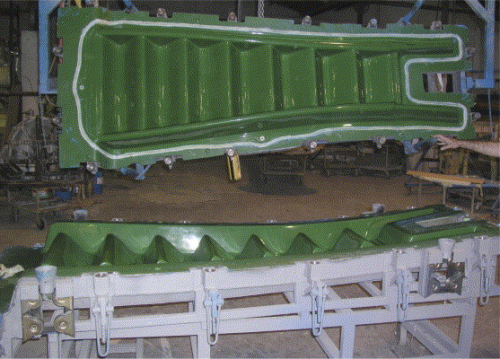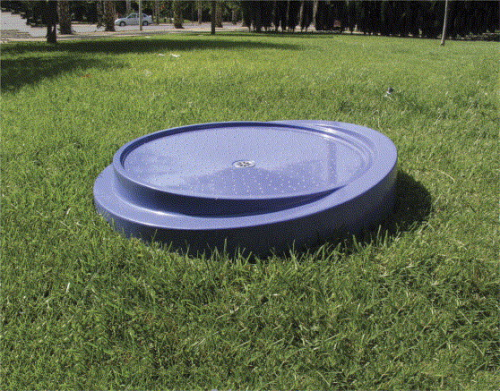

Resin transfer moulding (RTM) is normally used when a large production output of parts is required. The RTM tooling is formed by two mould halves which fit perfectly together, creating an encapsulated chamber where the reinforcement is placed and the resin is injected. Once the resin is injected and begins to cure, the polymerisation reaction releases a certain amount of heat (exotherm) that cannot be dissipated through the tooling thickness. Hence, the mould cavity behaves like an adiabatic chamber where the heat builds up to much higher temperatures than those developed in open mould techniques.
The excess of heat may provoke a release agent failure as most conventional release products cannot withstand such conditions. The result of using an unsuitable mould release agent or system may lead to the part sticking up on the tool surface and therefore severely damaging the mould as well as the part.
On the other hand, the RTM process is used to produce a high output of finished parts and this requires multiple release capability of the mould release system used. If the release agent applied over the tool surface is not adequate, frequent touch-ups will be needed to achieve a proper part release, leading to long delays in production. Also, frequent touch-up of a release agent produces a build-up of the product over the tool surface, and this effect may spoil the cosmetics of the part as well as making the extraction of the part very difficult. As a rule of thumb, excessive application of the release agent leads to more difficult release instead of an easy one.
In most cases, the parts manufactured with RTM exhibit only one gel-coated face and one non gel-coated face. The gel-coat is applied in the ‘mould’ and the non-gel coated face is released from the ‘countermould.’ The mould is normally the lower half of the tool and the countermould is the upper one. As a result of the flow of pure resin and fibre wear, the countermould is the tool where more chemical and physical attack is expected. Hence, the countermould needs a different surface treatment than the mould.
Because of this difference, most parts need different release solutions for mould and countermould respectively. As we always require the part to remain on the bottom upon release it is logical to use a high slip release coating in the upper half and a tighter one on the lower half. In other words, we require a very easy release from the countermould and a more tight release from the mould.
It is precisely this gradient in release power that calls for a differential slip releasing coating in both mould and countermould.
The solution
The release treatment applied to the countermould must provide a very high slip and in order to obtain this effect Zyvax recommends the following products:
- SEALER GP: a true polymer that effectively seals-off all the microporosity inherent to every tool surface; and
- WATERSHIELD: a 100% solvent-free release agent that offers extreme release power and multiple release performance.
Once the countermould has been treated with the above products, it is ready to produce very easy and consistent releases for many production cycles. The countermould main-tenance will only require occasional touch-ups of WaterShield when needed.
In the lower half (mould), we apply a lower slip release treatment such as:
- SEALER GP: same as above; and
- COMPOSITE SHIELD: a release agent with low slip features and high release yield.
The combination of these products will make sure that the part will also remain on the mould, perfectly replicating the tool finish.
Case studies
Spanish company Molder Disnova specialises in the manufacturing of slides for water theme parks using conventional RTM as well as RTM Light processing techniques. The nature of the business is such that the company needs to have a quick turn around of mouldings with different colours and shapes. Within this manufacturing scenario, RTM technology delivers the level of production required at the right tooling price. On top of that, the consistency in the quality of the parts is very high with low rejection rates. A very important operation within this environment is the part release.
In order to achieve the highest level of release performance, Molder Disnova chose the Zyvax release system to treat its RTM tooling. A close collaboration between the Zyvax technical service and Molder Disnova production management resulted in an overall improvement of the release process. This working team chose a combination of Zyvax products that delivered the best results.
Molder Disnova realised the advantages offered by Zyvax mould release system and decided to treat all its RTM tooling. The company saw improvements from the first release onwards. The moulds kept their gloss level and styrene build in the countermould disappeared. The production output reached very high levels and the time savings were clearly visible. The release operation became easier and more consistent.
In another example, Hired-Hand Technologies, a US manufacturer of industrial parts, uses an RTM process without gel-coat for its production. Without a gel-coat, the production group was challenged with excessive sticking and tool wear that sometimes caused surface defects on the part. These problems could cause the line to back up, impacting workforce efficiency and morale. Lack of an effective mould preparation and release system was not only hampering output, but was actually inhibiting growth for the company.
The use of the Zyvax release system has allowed Hired-Hand to double output on each shift, the moulds are maintaining lustre and ‘sheen,’ and new mould ‘break in’ has been eliminated from the production cycle. This has enabled Hired-Hand to increase production as well as introduce new products in an environment of predictable production outcome and created a workplace infused with enthusiasm and ‘can do’ productivity.
“We were experiencing extreme build-up on our moulds and having to spend days cleaning them before a new run,” says Keith Aaron, plant manager, Hired-Hand Technologies. “When we started using the Zyvax WaterClean and EnviroShield solvent-free products, we immediately were able to make the process more efficient. Our parts required little to no rework and it now takes only hours, not days, to clean the mould.”






